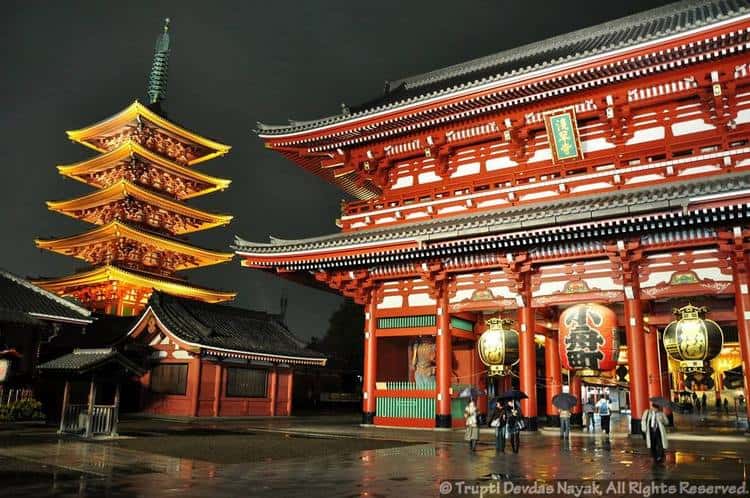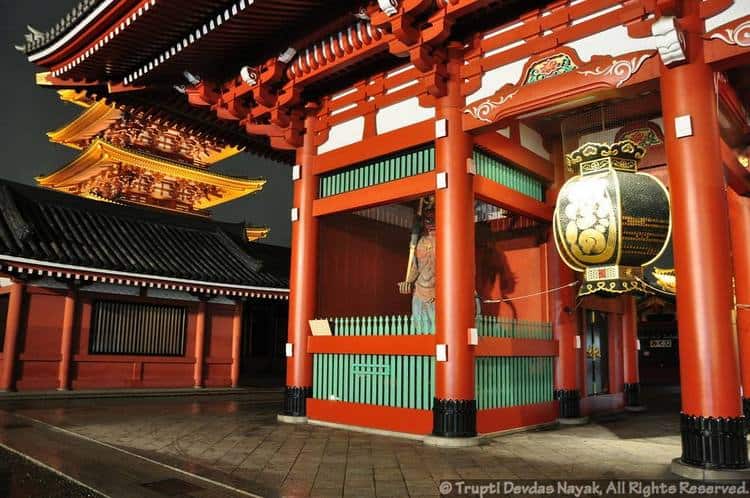Today’s guest post comes from beautiful Japan where Trupti Devdas Nayak of Exploring the Blue Marble takes us on a photographic journey to see some of Tokyo’s magical temples.
One of the oldest shrines in Tokyo, the beautiful Sensoji temple sits in the middle of the bustling town of Asakusa, an oddly familiar juxtaposition of the old against the new. People from all walks of life find time in their busy schedules to visit the shrine to seek blessings from the Kannon (also known as Guan Yin or the Goddess of Mercy). Even on a rainy evening in November, people braved the light drizzle and cold wind to take a moment to visit the temple and pray. Standing at the entrance to the shrine, looking at this grand scene, I understood why.
Approaching the entrance to the main inner shrine, one cannot help but be in awe of the luminosity and grandeur of Sensoji. The massive paper lanterns are gilded with gold paint, the towering five-tier pagoda glows as though on fire against the backdrop of the gray sky, the bold red paint symbolizes the expulsion of demons and evil. Sensoji in Asakusa was built in the seventh century and I realized I was standing at the threshold of one of the oldest temples in Tokyo where the footsteps of samurai warriors and village locals alike have stepped through over hundreds of years.
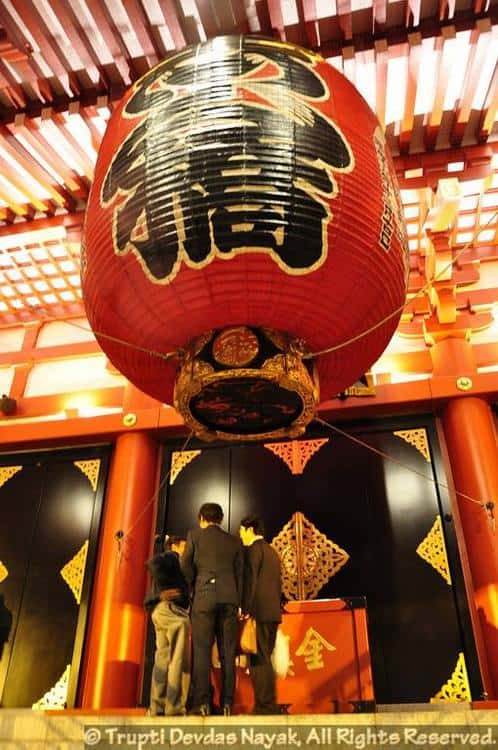
In the innermost part of the shrine visitors seek blessings from the Kannon by placing a coin in the box placed under an enormous red and black paper lantern. A sense of calm is felt the moment you enter this room. The high wooden beams of the ceiling, the luminous light, the richness of gold, red and black tones all contribute towards making one feel protected and at peace. Businessmen in suits stand alongside peasants and factory workers all praying for good health and happiness for their families.
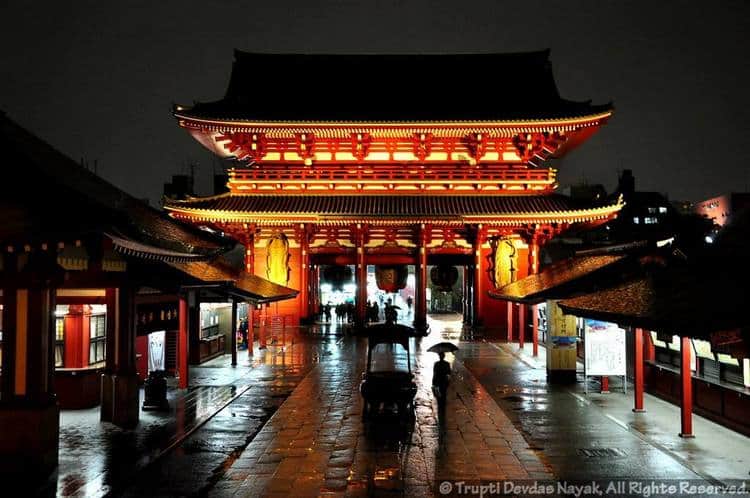 On leaving the inner shrine, this stunning symmetry greets us as we look out towards the gate and beyond at Nakamise-Dori. This grand entrance is called Kaminarimon or Thunder Gate, dominated by a massive red lantern painted with bold red and black Japanese characters.
On leaving the inner shrine, this stunning symmetry greets us as we look out towards the gate and beyond at Nakamise-Dori. This grand entrance is called Kaminarimon or Thunder Gate, dominated by a massive red lantern painted with bold red and black Japanese characters.
 There are two gargantuan sandals on either side of the gate belonging to the mythical giant who fiercely guards the Kaminarimon. The belief is that any person thinking wicked deeds will change their mind when they see the size of these sandals and envision the power of the mythical giant guarding against evil.
There are two gargantuan sandals on either side of the gate belonging to the mythical giant who fiercely guards the Kaminarimon. The belief is that any person thinking wicked deeds will change their mind when they see the size of these sandals and envision the power of the mythical giant guarding against evil.
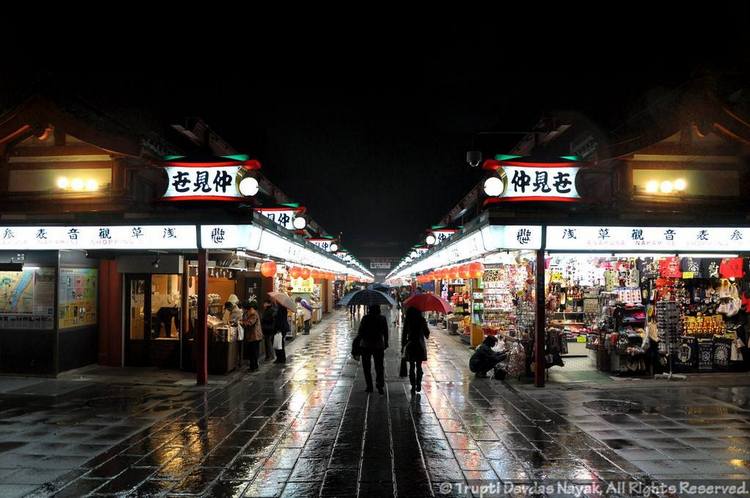 Nakamise-Dori is a quaint market street leading from the Thunder Gate into the bustling city streets lined with the shiny high rises synonymous with Tokyo. On either side of this market are hundreds of souvenir shops, selling everything from Japanese dolls, hand-made fans, kimonos, and edible seaweed crackers to authentic fake-food key-chains originally made in Kappa Bashi. This is a must-visit market for travelers looking to buy memorable souvenirs when in Asakusa. As you walk away from the serenity of the Sensoji temple, inhaling deeply the fresh air purified by the light drizzle of rain, Nakamise-Dori welcomes you with open arms, back into the joyful, bustling liveliness of Tokyo.
Nakamise-Dori is a quaint market street leading from the Thunder Gate into the bustling city streets lined with the shiny high rises synonymous with Tokyo. On either side of this market are hundreds of souvenir shops, selling everything from Japanese dolls, hand-made fans, kimonos, and edible seaweed crackers to authentic fake-food key-chains originally made in Kappa Bashi. This is a must-visit market for travelers looking to buy memorable souvenirs when in Asakusa. As you walk away from the serenity of the Sensoji temple, inhaling deeply the fresh air purified by the light drizzle of rain, Nakamise-Dori welcomes you with open arms, back into the joyful, bustling liveliness of Tokyo.
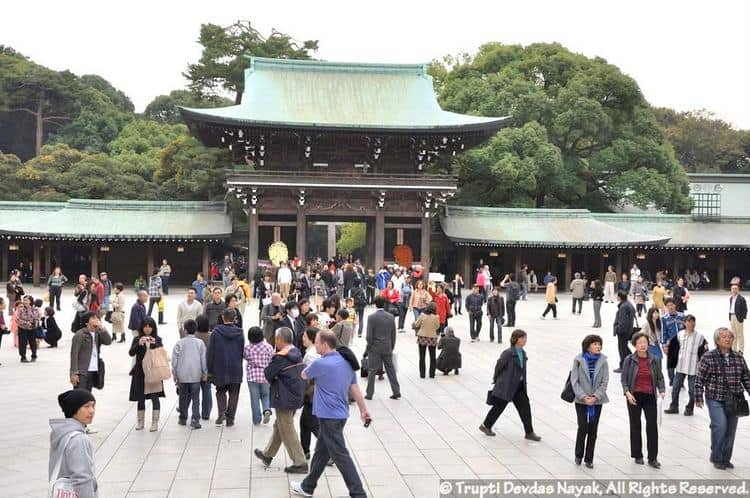
Meiji Jingu is a popular Shinto shrine also set in the heart of Tokyo. It is dedicated to Emperor Meiji and his Empress Shoken. A serendipitous visit in mid-November to Meiji Jingu allowed me to witness the celebration of the Shichi-Go-San festival that is held for three and seven year-old girls and three and five-year old boys. It is a traditional rite of passage into middle childhood for the young children who are dressed up in grand kimonos for the special occasion. I was lucky to be able to peek a bit into Japan’s culture and tradition, not to mention getting the opportunity to see the grandly decked up children – each one so adorable and beautiful with their proud parents and grandparents.
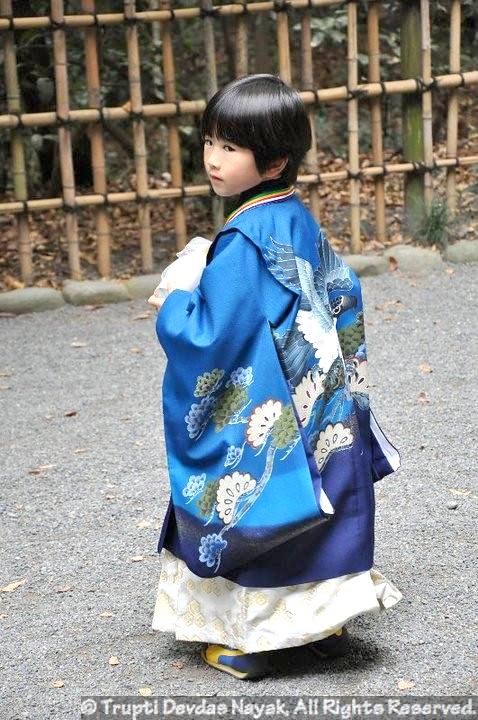
A young boy dressed up in a grand kimono for the first time for Shichi-Go-San
I remember reading about Shichi-Go-San in the Childcraft series of books for children as a young child. I must have been around seven or eight years-old then. For some reason, the festival had a lasting impression on me. It might have been the colorful pictures and photos of smiling children dressed in kimonos, it might have been the poetic name of the festival, it might have been my own desire to be celebrated as a child with a festival dedicated to being three, five or seven years-old. Whatever it may have been, fond memories of reading about this traditional rite of passage came flooding back as I witnessed the actual event for real.
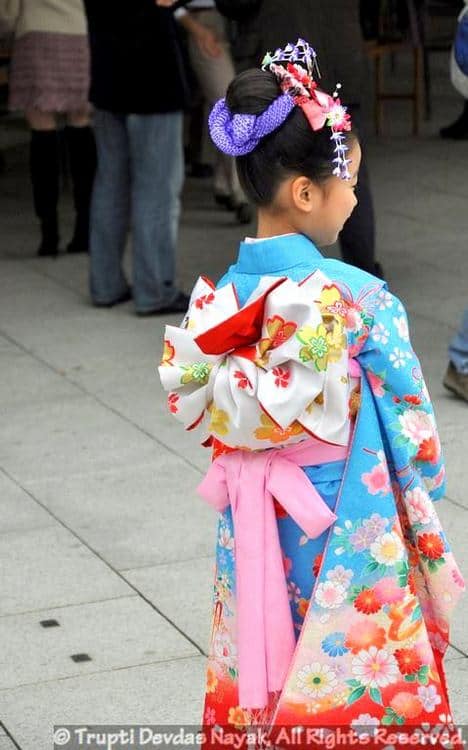
Tokyo little girl dressed up
A young girl dressed in a traditional kimono celebrating Shichi-Go-San. The children are not shy about posing for photographers. It is meant to be a day celebrating their entry into middle-childhood and some of them are wearing traditional kimonos for the first time.
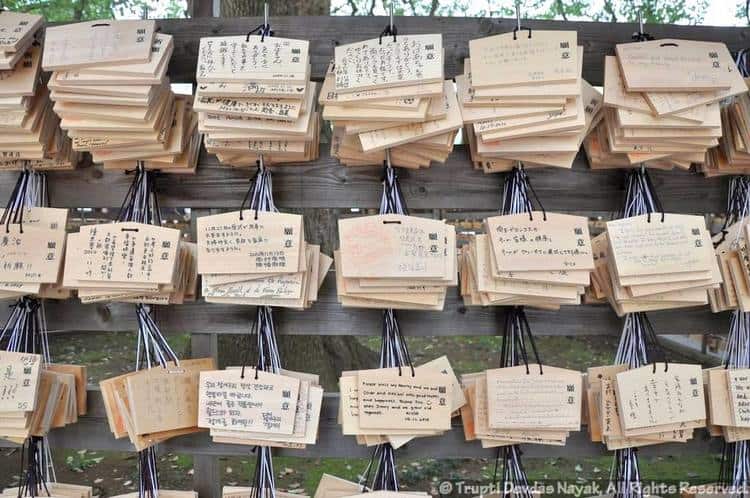
At Meiji Jingu, visitors can write prayers onto wooden plaques. These are meant to be prayers to uplift the spirit and well wishes for a long happy healthy life for oneself and loved ones.
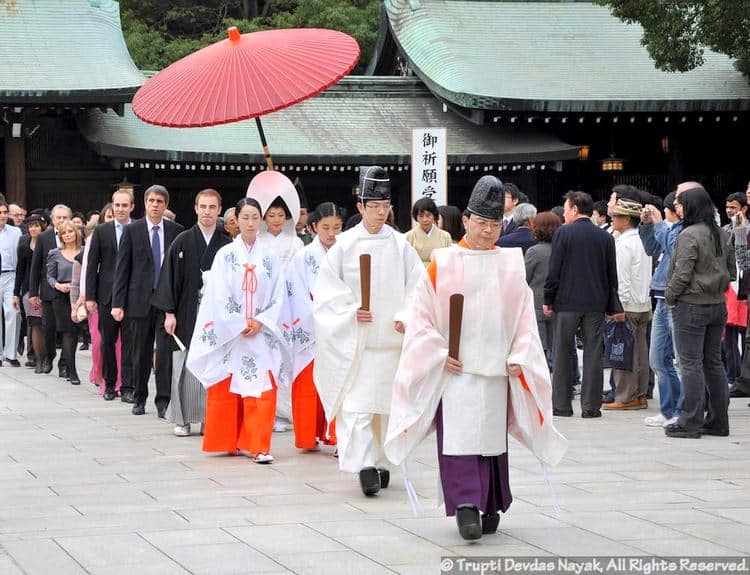
Shichi-Go-San is also an auspicious day to get married! This procession is led by the priests, followed by the shrine maidens also known as miko. Behind them are the groom and bride. The grooms wear black kimonos and the brides wear resplendent white. The families of the bride and groom and their relatives continue the procession behind. A traditional red oil-paper umbrella is held over the bride, symbolic of warding off evil spirits.
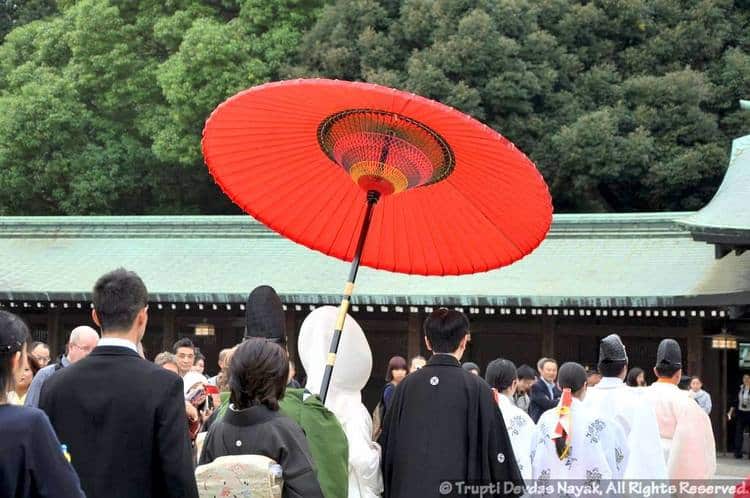
Shinto shrines allow weddings to be held on the premises for families wishing to get married in the traditional Japanese way. I witnessed three wedding processions one after another at Meiji Jingu. Perhaps Shichi-Go-San is considered a really auspicious day or I was just plain lucky!
There are many temples and shrines in Tokyo but Sensoji and Meiji Jingu are considered two of the oldest and most beautiful. No visit to Tokyo is complete without stepping into this sacred space at least once during your travels. Most people find it to be a calming and serene oasis in the middle of the bustling city and I’m sure you will too.
Bio: Trupti Devdas Nayak is a freelance writer and photographer who loves (and lives!) to travel. When not writing or traveling, she is busy planning her next adventure. Amongst other things, Trupti has trekked the Inca trail to Machu Picchu, snorkeled with sharks in Oahu, witnessed horses dancing flamenco in Andalusia and she has hiked in over 30 national parks around the world and counting. Trupti has explored many parts of Asia, the Americas and Europe and writes about her experiences at Exploring the Blue Marble. All photos in this post are by Trupti Devdas Nayak.
